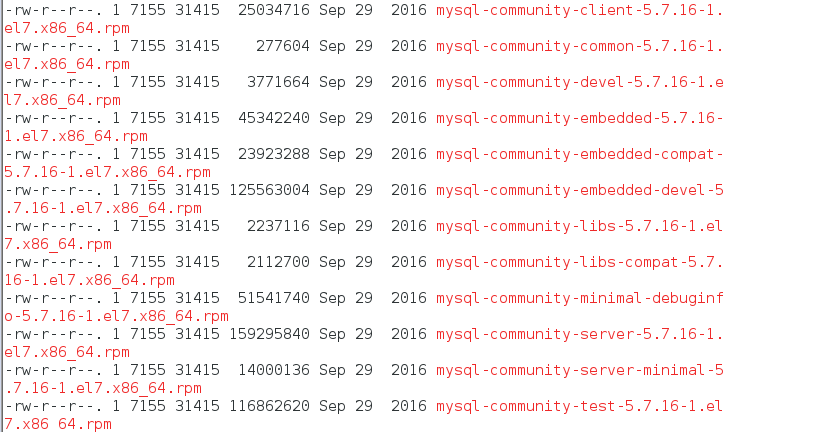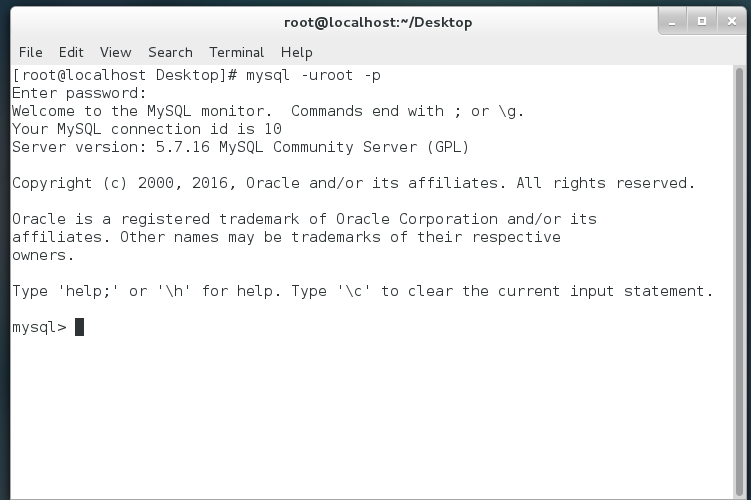Centos7 installation mysql5.7.16 database instance analysis
Version: mysql-5.7.16-1.el7.x86_64.rpm-bundle.tar
Note: You need to confirm the current system before installation Is there MySQL? If so, it must be uninstalled (centos7 comes with MariaDB database, so the first step is to uninstall the database)
View the MySQL database:
rpm -qa | grep -i mysql
Uninstall the MySQL database:
rpm -e [mysql文件名]
If there are associated files, they cannot be uninstalled directly. You can use the following command to force uninstall
rpm -e --nodeps [mysql文件名]
1. Copy mysql-5.7.16-1.el7.x86_64.rpm-bundle.tar to /home/ (install software under linux , generally you need to copy the files to the home directory)
cp mysql-5.7.16-1.el7.x86_64.rpm-bundle.tar /home/
2. Unzip the files
tar -xvf mysql-5.7.16-1.el7.x86_64.rpm-bundle.tar
The following are all the rpm files extracted

3. Unzip and install the rpm file
1. Generally, you only need to install the following files

2. Next, use the commands to decompress the rpm files one by one and install them.
Note: There is a detail that you need to pay attention to. The above files are also included in the installation. Sequentially, he has corresponding priority. So you need to unzip and install one by one in the following order
mysql-community-common-5.7.16-1.el7.x86_64 mysql-community-libs-5.7.16-1.el7.x86_64 mysql-community-client-5.7.16-1.el7.x86_64 mysql-community-server-5.7.16-1.el7.x86_64 mysql-community-devel-5.7.16-1.el7.x86_64
4. After the installation is successful, start the mysql service
systemctl start mysqld.service
5. Check the 3306 port Whether to enable
netstat -ln | grep 3306

6. Modify the my.cnf configuration file
1. This step requires finding my.cnf document. The default path of the my.cnf file is /etc/my.cnf
2. Edit my.cnf
vim /etc/my.cnf

3. Press 'i' to enter After inserting the mode, insert the following code
[mysqld] datadir=/var/lib/mysql socket=/var/lib/mysql/mysql.sock symbolic-links=0 log-error=/var/log/mysqld.log pid-file=/var/run/mysqld/mysqld.pid validate_password=off default-storage-engine=innodb character-set-server=utf8 collation-server=utf8_general_ci
Note: validate_password=off means to turn off the password verification plug-in (this sentence must be added, because if it is not added when changing the password, it will Very troublesome).
4. Save and exit (press 'esc', then enter ':wq')

5 Restart the mysql service
systemctl restart mysqld.service
7. This step is particularly important. Each previous step must be carefully tested and executed successfully.
1. Initialization table
/user/sbin/mysqld --initialize --user=mysql
2. After initialization, a mysql zero-time login password will be generated, so where can I check it? The log path configured earlier in the my.cnf file is log-error=/var/log/mysqld.log. Check the mysqld.log log under this path and find the zero-hour password
cat /var/log/mysqld.log |grep password
3. According to Use the zero-hour password to re-modify the password of the mysql database
mysql_secure_installation
4. After pressing Enter, he will ask you to enter the password. You only need to enter the zero-hour password.
5. After entering the correct password, enter the new password and confirm.
8. After successfully changing the password, you can log in to mysql

The above is the detailed content of Centos7 installation mysql5.7.16 database instance analysis. For more information, please follow other related articles on the PHP Chinese website!

Hot AI Tools

Undresser.AI Undress
AI-powered app for creating realistic nude photos

AI Clothes Remover
Online AI tool for removing clothes from photos.

Undress AI Tool
Undress images for free

Clothoff.io
AI clothes remover

AI Hentai Generator
Generate AI Hentai for free.

Hot Article

Hot Tools

Notepad++7.3.1
Easy-to-use and free code editor

SublimeText3 Chinese version
Chinese version, very easy to use

Zend Studio 13.0.1
Powerful PHP integrated development environment

Dreamweaver CS6
Visual web development tools

SublimeText3 Mac version
God-level code editing software (SublimeText3)

Hot Topics
 PHP's big data structure processing skills
May 08, 2024 am 10:24 AM
PHP's big data structure processing skills
May 08, 2024 am 10:24 AM
Big data structure processing skills: Chunking: Break down the data set and process it in chunks to reduce memory consumption. Generator: Generate data items one by one without loading the entire data set, suitable for unlimited data sets. Streaming: Read files or query results line by line, suitable for large files or remote data. External storage: For very large data sets, store the data in a database or NoSQL.
 How to use MySQL backup and restore in PHP?
Jun 03, 2024 pm 12:19 PM
How to use MySQL backup and restore in PHP?
Jun 03, 2024 pm 12:19 PM
Backing up and restoring a MySQL database in PHP can be achieved by following these steps: Back up the database: Use the mysqldump command to dump the database into a SQL file. Restore database: Use the mysql command to restore the database from SQL files.
 How to optimize MySQL query performance in PHP?
Jun 03, 2024 pm 08:11 PM
How to optimize MySQL query performance in PHP?
Jun 03, 2024 pm 08:11 PM
MySQL query performance can be optimized by building indexes that reduce lookup time from linear complexity to logarithmic complexity. Use PreparedStatements to prevent SQL injection and improve query performance. Limit query results and reduce the amount of data processed by the server. Optimize join queries, including using appropriate join types, creating indexes, and considering using subqueries. Analyze queries to identify bottlenecks; use caching to reduce database load; optimize PHP code to minimize overhead.
 How to insert data into a MySQL table using PHP?
Jun 02, 2024 pm 02:26 PM
How to insert data into a MySQL table using PHP?
Jun 02, 2024 pm 02:26 PM
How to insert data into MySQL table? Connect to the database: Use mysqli to establish a connection to the database. Prepare the SQL query: Write an INSERT statement to specify the columns and values to be inserted. Execute query: Use the query() method to execute the insertion query. If successful, a confirmation message will be output.
 How to create a MySQL table using PHP?
Jun 04, 2024 pm 01:57 PM
How to create a MySQL table using PHP?
Jun 04, 2024 pm 01:57 PM
Creating a MySQL table using PHP requires the following steps: Connect to the database. Create the database if it does not exist. Select a database. Create table. Execute the query. Close the connection.
 How to use MySQL stored procedures in PHP?
Jun 02, 2024 pm 02:13 PM
How to use MySQL stored procedures in PHP?
Jun 02, 2024 pm 02:13 PM
To use MySQL stored procedures in PHP: Use PDO or the MySQLi extension to connect to a MySQL database. Prepare the statement to call the stored procedure. Execute the stored procedure. Process the result set (if the stored procedure returns results). Close the database connection.
 How to fix mysql_native_password not loaded errors on MySQL 8.4
Dec 09, 2024 am 11:42 AM
How to fix mysql_native_password not loaded errors on MySQL 8.4
Dec 09, 2024 am 11:42 AM
One of the major changes introduced in MySQL 8.4 (the latest LTS release as of 2024) is that the "MySQL Native Password" plugin is no longer enabled by default. Further, MySQL 9.0 removes this plugin completely. This change affects PHP and other app
 The difference between oracle database and mysql
May 10, 2024 am 01:54 AM
The difference between oracle database and mysql
May 10, 2024 am 01:54 AM
Oracle database and MySQL are both databases based on the relational model, but Oracle is superior in terms of compatibility, scalability, data types and security; while MySQL focuses on speed and flexibility and is more suitable for small to medium-sized data sets. . ① Oracle provides a wide range of data types, ② provides advanced security features, ③ is suitable for enterprise-level applications; ① MySQL supports NoSQL data types, ② has fewer security measures, and ③ is suitable for small to medium-sized applications.






